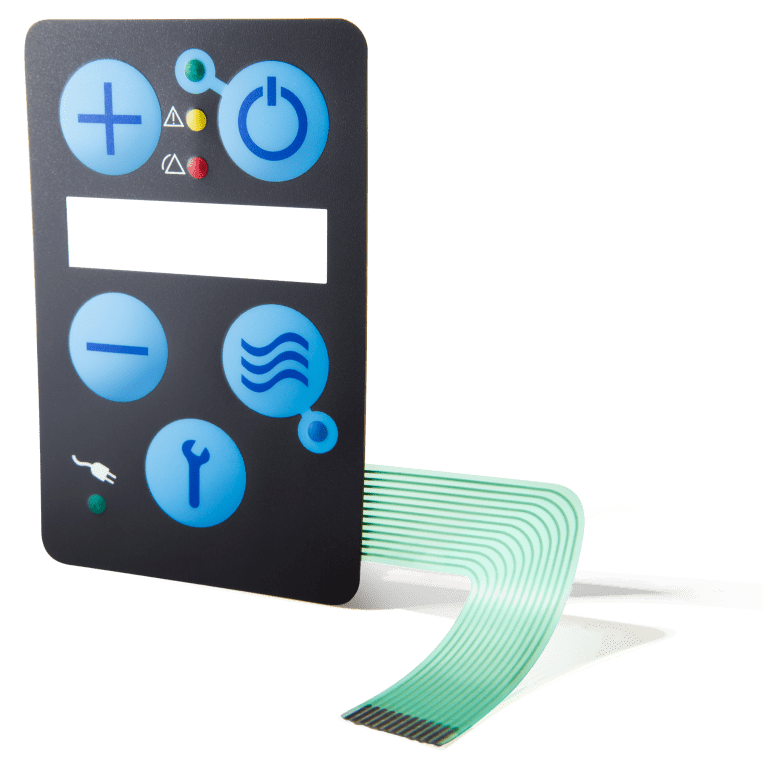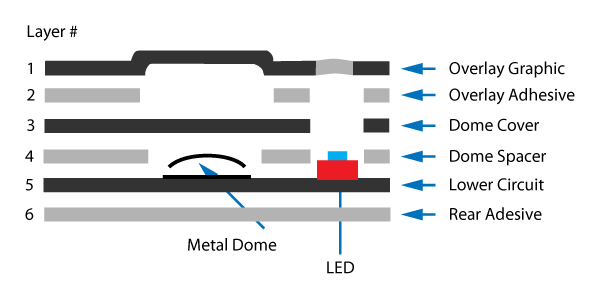Everything About Membrane layer Switch: A Comprehensive Guide for Beginners
Membrane buttons are crucial elements in modern-day electronics, providing an unique user interface for individual interaction - membrane switch. Their split building and construction, consisting of overlays and conductive traces, gives capability and sturdiness. Unlike typical mechanical buttons, membrane layer switches provide a smooth design and customizable options. Recognizing their crucial features and benefits can transform product style. The details of their application and layout factors to consider require additional exploration.
What Is a Membrane layer Switch?
A membrane button is a kind of electric switch that contains an adaptable membrane layer layered over a printed circuit card. This style permits a streamlined and compact user interface, commonly used in numerous electronic devices. Membrane layer buttons are commonly found in consumer home appliances, clinical tools, and industrial equipment as a result of their sturdiness and resistance to ecological factors.The building typically includes multiple layers, such as graphic overlays and adhesive support, which supply responsive responses and secure the circuitry beneath. The procedure of a membrane switch is started when stress is put on the surface area, finishing an electric circuit.These buttons are valued for their versatility, enabling custom designs and published graphics that satisfy specific interface. Their inconspicuous nature reduces room requirements, making them suitable for applications where typical buttons might not fit. Overall, membrane layer buttons supply a visual and functional service for modern digital tools.
Key Components of Membrane Layer Switches Over
Membrane switches over consist of numerous crucial elements that add to their capability and efficiency. The top layer, called the overlay, provides the customer interface and is usually printed with graphics or signs. Underneath the overlay lies a spacer layer, which separates the conductive components and prevents unintended activation. The following vital part is the visuals layer, which enhances aesthetics and assures the toughness of the design.Conductive traces, commonly made from materials like silver or carbon, are printed on the circuit layer. When stress is applied to the overlay, these traces come right into call, completing the circuit. Furthermore, a support layer supplies structural assistance and can be made from materials such as polyester or polycarbonate. With each other, these parts develop a reputable, straightforward interface ideal for various applications, from family appliances to commercial equipment. Comprehending these aspects is important for any person curious about membrane button innovation.
Exactly How Membrane Switches Over Work
Recognizing exactly how membrane switches over feature is essential for valuing their prevalent use in numerous tools. A membrane button runs via a series of layers, consisting of a visuals overlay, spacer, and a circuit layer. When stress is related to the overlay, it compresses the spacer layer, permitting the circuit layer to make get in touch with and finish an electrical circuit. This action sends out a signal to the device, prompting an action, such as switching on a light or activating a function.Membrane changes can be designed with numerous functions, consisting of tactile responses, backlighting, and customized graphics, improving individual interaction. Their building and construction enables a sealed layout, safeguarding the interior parts from dust, dampness, and contaminants. This toughness makes them suitable for varied applications, from customer electronic devices to industrial devices. On the whole, the simpleness and performance of membrane layer switches contribute to their popularity in contemporary technology.
Advantages of Membrane Changes Over Mechanical Buttons
While mechanical switches have actually long been a staple in several devices, membrane layer switches deal distinctive benefits that make them increasingly appealing. One substantial advantage is their slim account, allowing for more small layouts and better adaptability in product development. Additionally, membrane layer switches feature an uniform surface area, which improves visual charm and streamlines cleaning, making them appropriate for settings where health is critical.Another benefit is their resistance to dust and wetness. Unlike mechanical buttons, which can be endangered by environmental variables, membrane switches supply a sealed user interface that shields versus pollutants - membrane switch. In addition, membrane buttons typically have a longer life-span as a result of fewer moving parts, causing enhanced resilience and reliability.Cost-effectiveness is likewise a significant advantage, as membrane switches can be produced wholesale with reduced manufacturing prices. These elements combine to place membrane layer switches as a practical choice to standard mechanical options in various applications
Usual Applications of Membrane Layer Switches Over
Membrane layer buttons are commonly utilized in numerous industries, particularly in customer electronic devices and commercial control panels. In consumer tools, they supply a streamlined, straightforward interface, while in commercial setups, they improve resilience and functionality. Recognizing these applications highlights the versatility and practicality of membrane switches in contemporary innovation.
Customer Electronics Tools
As consumer electronics continue to evolve, membrane layer switches have come to be a popular selection for a range of devices due to their adaptability and streamlined layout. These switches are commonly discovered in mobile phones, tablet computers, and remotes, where room is restricted and aesthetic appeals matter. Their low profile and customizable designs enable makers to develop user-friendly user interfaces that enhance the general individual experience. Additionally, membrane layer switches are often utilized in home appliances such as microwaves and coffee machine, giving intuitive control options while resisting wetness and dirt. The toughness and integrity of membrane layer changes make them ideal for day-to-day consumer items, ensuring longevity and regular efficiency. Overall, their assimilation in customer electronic devices shows a blend of capability and contemporary design.
Industrial Control Panels
The applications of membrane layer switches prolong beyond consumer electronic devices, locating substantial usage in commercial control board. These switches are preferred for their sturdiness and resistance to extreme settings, making them perfect for producing and procedure control setups. They give a trustworthy user interface for operators to manage equipment, display processes, and change setups. Membrane buttons can be personalized to match certain functional demands, integrating functions like backlighting and responsive comments, enhancing individual experience. Their low-profile layout allows for integration into different devices, while their ability to endure spills, dirt, and severe temperatures warranties longevity. In general, membrane buttons contribute to effective and secure operation in commercial applications, showing their adaptability and performance sought after settings.
Considerations for Designing Membrane Layer Switches
When creating membrane switches, picking the appropriate products is necessary to ensure sturdiness and capability. Furthermore, comprehending layer arrangement strategies can greatly affect the button's performance and individual experience. These considerations play a vital role in creating reliable and reputable membrane button designs.
Material Selection Value
Material choice plays a crucial function in the style and capability of membrane switches. The picked products straight affect the switch's longevity, tactile action, and total visual. Key factors to consider consist of the substratum, which must provide architectural integrity while enabling versatility, and the visuals overlay, which requires to be resistant to put on and ecological elements. Conductive products must ensure dependable electrical efficiency, while adhesives have to provide he said strong bonding without endangering the button's operation. Additionally, compatibility with making procedures and end-user atmospheres is vital; products need to hold up against varying temperature levels, moisture levels, and chemical exposure. Inevitably, ideal material option not only boosts the membrane button's efficiency however additionally contributes to its durability and user satisfaction, making it an important facet of the layout process.

Layer Configuration Methods

Often Asked Inquiries
How Much Time Do Membrane Layer Switches Over Generally Last?
Membrane layer switches generally have a life-span of 1 to 5 million cycles, depending upon usage and environmental conditions. Aspects such as style high quality and operating regularity significantly influence their toughness and general efficiency longevity.

Can Membrane Layer Switches Be Customized for Details Designs?
Membrane layer buttons can undoubtedly be tailored to suit certain styles, enabling for varied forms, shades, and performances. This adaptability allows makers to customize these switches to satisfy distinct visual and operational demands efficiently.
What Products Are Used in Membrane Layer Switch Construction?
Membrane layer switches are typically created utilizing products such as polyester, polycarbonate, and glue layers. These materials give resistance, resilience, and flexibility to ecological variables, ensuring the buttons function effectively in different applications and problems.
Are Membrane Layer Switches Over Immune or water resistant to Dampness?
Membrane buttons can be developed to be moisture-resistant, making use of specialized finishes and materials. However, their water resistant capacities rely on building quality and specific applications, making it necessary to examine needs for suitable efficiency in various environments.
Just How Are Membrane Switches Over Repaired if Harmed?
Repairing damaged membrane layer switches over usually includes changing the influenced layer Resources or circuit. Professionals might likewise apply conductive adhesive or utilize specialized repair work packages, making certain capability is restored without complete replacement of the entire button setting up. Unlike standard mechanical buttons, membrane layer buttons present a sleek style and customizable alternatives. A membrane switch is a type of electric switch that consists of a flexible membrane layered over a printed circuit board. The operation of a membrane button is started when pressure is applied to the surface, completing an electric circuit.These buttons are valued for their convenience, allowing customized designs and published graphics that provide to certain customer interfaces. While mechanical buttons have long been a staple in numerous tools, membrane layer switches over offer distinctive advantages that make them significantly appealing. Membrane layer switches typically have a longer lifespan due to fewer relocating parts, resulting in enhanced toughness and reliability.Cost-effectiveness is likewise a blog notable advantage, as membrane layer switches can be generated in mass with lower manufacturing expenses.